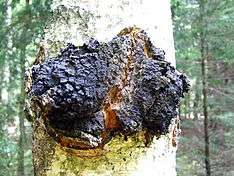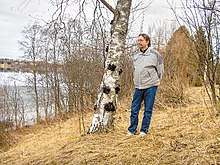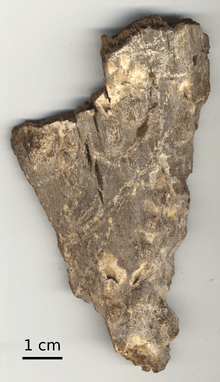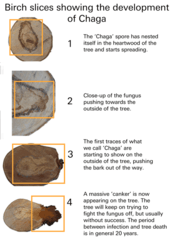Inonotus obliquus
| Inonotus obliquus | |
|---|---|
 | |
| Scientific classification | |
| Kingdom: | Fungi |
| Division: | Basidiomycota |
| Class: | Agaricomycetes |
| Order: | Hymenochaetales |
| Family: | Hymenochaetaceae |
| Genus: | Inonotus |
| Species: | I. obliquus |
| Binomial name | |
| Inonotus obliquus | |
| Synonyms[1] | |
|
Boletus obliquus Ach. ex Pers. (1801) | |
| Inonotus Obliquus | |
|---|---|
|
| |
| smooth hymenium | |
| no distinct cap | |
| hymenium attachment is not applicable | |
| lacks a stipe | |
| ecology is parasitic | |
| edibility: edible | |
Inonotus obliquus, commonly known as chaga mushroom (a Latinisation of the Russian word чага), is a fungus in the family Hymenochaetaceae. It is parasitic on birch and other trees. The sterile conk is irregularly formed and has the appearance of burnt charcoal. It is not the fruiting body of the fungus, but a sclerotium or mass of mycelium, mostly black because of the presence of massive amounts of melanin.
I. obliquus is found most commonly in the circumboreal region of the Northern Hemisphere where it is distributed in birch forests.[2]
Morphology



I. obliquus causes a white heart rot to develop in the host tree. The chaga spores enter the tree through wounds, particularly poorly healed branch stubs. The white rot decay will spread throughout the heartwood of the host. During the infection cycle, penetration of the sapwood occurs only around the sterile exterior mycelium mass.[2] The chaga fungus will continue to cause decay within the living tree for 10-80+ years. While the tree is alive, only sterile mycelial masses are produced (the black exterior conk). The sexual stage begins after the tree, or some portion of the tree, is killed by the infection. I. obliquus will begin to produce fertile fruiting bodies underneath the bark. These bodies begin as a whitish mass that turn to brown with time. Since the sexual stage occurs almost entirely under the bark, the fruiting body is rarely seen.[3] These fruiting bodies produce basidiospores which will spread the infection to other vulnerable trees.
Alternative names
The name chaga (/ˈtʃɑːɡə/ ) comes from the Russian name of the mushroom (transliterated from чага), which in turn is purportedly derived from the word for the fungus in Komi-Permyak, the language of the indigenous peoples in the Kama River Basin, west of the Ural Mountains. It is also known as the clinker polypore (from its resemblance to the slag left after a coal fire, known commonly as a "clinker" when coal fires were common), cinder conk, black mass and birch canker polypore.[4] In England and officially in Canada, it is known as the sterile conk trunk rot of birch.[5] In North America, it is commonly referred to by its Russian name, chaga. In France, it is called the carie blanche spongieuse de bouleau (spongy white birch tree rot), and in Germany it is known as Schiefer Schillerporling (oblique Inonotus). The Dutch name is berkenweerschijnzwam (birch glow mushroom). In Norwegian, the name is kreftkjuke which literally translates as "cancer polypore", referring to the fungus' appearance or to its alleged medicinal properties. In Finnish, the name is pakurikääpä.
Distribution and cultivation
Generally found growing on Birch (Betula spp.) trees, it has also been found on Alder (Alnus spp.), Beech (Fagus spp.), Oak (Quercus spp.) and Poplar (Populus spp.).[6] In species other than birch, the fungus often appears as buried stem cancer, instead of the charcoal like mass found on birch trees.
Attempts at cultivating this fungus on potato dextrose agar and other simulated mediums resulted in a reduced and markedly different production of metabolites.[7][8] Cultivated chaga developed a reduced number of phytosterols, particularly lanosterol, an intermediate in the synthesis of ergosterol and lanostane-type triterpenes.[7]
Preparation
Chaga is traditionally grated into a fine powder and used to brew a beverage resembling coffee or tea. Currently, three extraction processes are used, each with a different outcome.
- Hot water extraction is the most common and the cheapest method. The ß-D-glucans may have a content of ±35% in a pure extract.[9]
- Ethanol or methanol extraction isolates the water-insoluble components, betulinic acid, betulin and the phytosterols. This extraction process is in general used as a second step after hot-water extraction, since ethanol alone will not break down chitin effectively - heat is essential.
- Fermentation is the most time-consuming, so is the most expensive; this method is not used very often. Because fermentation methods are not standardized (many types of bacteria and fungi can be used in the process), the outcome is also not standardized.
Cheap, mass-produced extracts are in general hot water, low percentage (4-20%) polysaccharide extracts.
See also
References
- ↑ "Inonotus obliquus (Ach. ex Pers.) Pilát 1942". MycoBank. International Mycological Association. Retrieved 2011-10-11.
- 1 2 Lee, Min-Woong; Hur, Hyeon; Chang, Kwang-Choon; Lee, Tae-Soo; Ka, Kang-Hyeon; Jankovsky, L. (December 2008). "Introduction to Distribution and Ecology of Sterile Conks of Inonotus obliquus". Mycobiology. 36 (4): 199–202. doi:10.4489/MYCO.2008.36.4.199. ISSN 1229-8093. PMC 3755195. PMID 23997626.
- ↑ MushroomExpert.Com. "Inonotus obliquus (MushroomExpert.Com)". www.mushroomexpert.com. Retrieved 2017-08-15.
- ↑ Needham, Arthur (2005-12-16). "Clinker Polypore, Chaga". Retrieved 10 October 2011.
- ↑ "Sterile conk trunk rot of birch". Canadian Forest Service, Natural Resources Canada, Government of Canada. 4 August 2015. Retrieved 15 August 2017.
- ↑ Ryvarden L, Gilbertson RL (1993). European polypores. Part 1. Oslo: Fungiflora-Fungiflora. pp. 1–387.
- 1 2 Zheng, W. F.; Liu, T.; Xiang, X. Y.; Gu, Q. (July 2007). "Sterol composition in field-grown and cultured mycelia of Inonotus obliquus". Yao xue xue bao = Acta pharmaceutica Sinica. 42 (7): 750–756. PMID 17882960.
- ↑ Zheng W, Miao K, Liu Y, Zhao Y, Zhang M, Pan S, et al. (2010). "Chemical diversity of biologically active metabolites in the sclerotia of Inonotus obliquus and submerged culture strategies for up-regulating their production". Appl Microbiol Biotechnol. 87 (4): 1237–54. doi:10.1007/s00253-010-2682-4. PMID 20532760.
- ↑ Rhee, S.Y. (2008). "A comparative study of analytical methods for alkali-soluble β-glucan in medicinal mushroom, Chaga (Inonotus obliquus)". LWT - Food Science and Technology. 41 (3): 545–549. doi:10.1016/j.lwt.2007.03.028.